An Accurate UAV Ground Landing Station System Based on BLE-RSSI and Maximum Likelihood Target Position Estimation
Abstract
:1. Introduction
2. Related Work
3. Ground Landing Station Design
3.1. Battery–UAV Coupling System
3.2. Battery Swapping Mechanism
3.3. Battery Storage System
3.4. Landing Surface
4. Electronic Sensing Design for MLE-Based Position Estimation
4.1. Electronic HW Configuration
4.2. MLE Position Estimation Algorithm
5. Experimental Results
5.1. RSSI Attenuation and Digital Filtering Analysis
5.2. MLE Target Position Estimation
6. Discussion
7. Conclusions
Author Contributions
Funding
Institutional Review Board Statement
Informed Consent Statement
Data Availability Statement
Conflicts of Interest
References
- Uddin, M.A.; Mansour, A.; Jeune, D.L.; Ayaz, M.; Aggoune, E.-H. UAV-Assisted Dynamic Clustering of Wireless Sensor Networks for Crop Health Monitoring. Sensors 2018, 18, 555. [Google Scholar] [CrossRef] [PubMed] [Green Version]
- Hayajneh, M.; Melega, M.; Marconi, L. Design of autonomous smartphone based quadrotor and implementation of navigation and guidance systems. Mechatronics 2018, 49, 119–133. [Google Scholar] [CrossRef]
- Liao, Y.-H.; Juang, J.-G. Real-Time UAV Trash Monitoring System. Appl. Sci. 2022, 12, 1838. [Google Scholar] [CrossRef]
- Aslan, M.F.; Durdu, A.; Sabanci, K.; Ropelewska, E.; Gültekin, S.S. A Comprehensive Survey of the Recent Studies with UAV for Precision Agriculture in Open Fields and Greenhouses. Appl. Sci. 2022, 12, 1047. [Google Scholar] [CrossRef]
- Shi, W.; Zhou, H.; Li, J.; Xu, W.; Zhang, N.; Shen, X. Drone Assisted Vehicular Networks: Architecture, Challenges and Opportunities. IEEE Netw. 2018, 32, 130–137. [Google Scholar] [CrossRef]
- Abeywickrama, H.V.; Jayawickrama, B.A.; He, Y.; Dutkiewicz, E. Comprehensive Energy Consumption Model for Unmanned Aerial Vehicles, Based on Empirical Studies of Battery Performance. IEEE Access 2018, 6, 58383–58394. [Google Scholar] [CrossRef]
- Sang-Won, K.; In-Kui, C.; Sung-Yong, H. Comparison of charging region differences according to receiver structure in drone wireless charging system. In Proceedings of the International Conference on Information and Communication Technology Convergence (ICTC), Jeju Island, Korea, 20–22 October 2017; pp. 1058–1060. [Google Scholar] [CrossRef]
- Barrett, E.; Reiling, M.; Mirhassani, S.; Meijering, R.; Jager, J.; Mimmo, N.; Callegati, F.; Marconi, L.; Carloni, R.; Stramigioli, S. Autonomous Battery Exchange of UAVs with a Mobile Ground Base. In Proceedings of the IEEE International Conference on Robotics and Automation (ICRA), Brisbane, Australia, 21–25 May 2018; pp. 699–705. [Google Scholar]
- Zhou, S.; Pollard, J.K. Position measurement using Bluetooth. IEEE Trans. Consum. Electron. 2006, 52, 555–558. [Google Scholar] [CrossRef]
- Wang, J.; Park, J.G. A Novel Indoor Ranging Algorithm Based on a Received Signal Strength Indicator and Channel State Information Using an Extended Kalman Filter. Appl. Sci. 2020, 10, 3687. [Google Scholar] [CrossRef]
- Fujii, K.; Higuchi, K.; Rekimoto, J. Endless Flyer: A Continuous Flying Drone with Automatic Battery Replacement. In Proceedings of the IEEE 10th International Conference on Ubiquitous Intelligence & Computing and IEEE 10th International Conference on Autonomic & Trusted Computing (UIC/ATC), Vietri sul Mare, Italy, 18–21 December 2013; pp. 216–223. [Google Scholar] [CrossRef]
- Ure, N.K.; Chowdhary, G.; Toksoz, T.; How, J.P.; Vavrina, M.A.; Vian, J. An Automated Battery Management System to Enable Persistent Missions with Multiple Aerial Vehicles. IEEE/ASME Trans. Mechatron. 2015, 20, 275–286. [Google Scholar] [CrossRef]
- Lin, Q.; Son, J. Analysis of Bluetooth RSSI for Proximity Detection of Ship Passengers. Appl. Sci. 2022, 12, 517. [Google Scholar] [CrossRef]
- Swieringa, K.A.; Hanson, C.B.; Richardson, J.R.; White, J.D.; Hasan, Z.; Qian, E.; Girard, A. Autonomous battery swapping system for small-scale helicopters. In Proceedings of the IEEE International Conference on Robotics and Automation, Anchorage, AK, USA, 3–7 May 2010; pp. 3335–3340. [Google Scholar] [CrossRef]
- Lee, D.; Zhou, J.; Lin, W.T. Autonomous battery swapping system for quadcopter. In Proceedings of the International Conference on Unmanned Aircraft Systems (ICUAS), Denver, CO, USA, 9–12 June 2015; pp. 118–124. [Google Scholar] [CrossRef]
- Choi, C.H.; Jang, H.J.; Lim, S.G.; Lim, H.C.; Cho, S.H.; Gaponov, I. Automatic wireless drone charging station creating essential environment for continuous drone operation. In Proceedings of the International Conference on Control, Automation and Information Sciences (ICCAIS), Ansan, Korea, 27–29 October 2016; pp. 132–136. [Google Scholar] [CrossRef]
- Li, G.; Geng, E.; Ye, Z.; Xu, Y.; Lin, J.; Pang, Y. Indoor Positioning Algorithm Based on the Improved RSSI Distance Model. Sensors 2018, 18, 2820. [Google Scholar] [CrossRef] [PubMed] [Green Version]
- Gu, Y.; Quan, L.; Ren, F.; Li, J. Fast Indoor Localization of Smart Hand-Held Devices Using Bluetooth. In Proceedings of the 10th International Conference on Mobile Ad-hoc and Sensor Networks, Maui, HI, USA, 19–21 December 2014; pp. 186–194. [Google Scholar] [CrossRef]
- Contreras, D.; Castro, M.; Torre, D. Performance evaluation of bluetooth low energy in indoor positioning systems. Trans. Emerg. Telecommun. Technol. 2017, 28, e2864. [Google Scholar] [CrossRef] [Green Version]
- Jianyong, Z.; Haiyong, L.; Zili, C.; Zhaohui, L. RSSI based Bluetooth low energy indoor positioning. In Proceedings of the International Conference on Indoor Positioning and Indoor Navigation (IPIN), Busan, Korea, 27–30 October 2014; pp. 526–533. [Google Scholar] [CrossRef]
- Rodas, J.; Fernandez, T.M.; Iglesia, D.I.; Escudero, C.J. Multiple Antennas Bluetooth System for RSSI Stabilization. In Proceedings of the 4th International Symposium on Wireless Communication Systems, Trondheim, Norway, 17–19 October 2007; pp. 652–656. [Google Scholar] [CrossRef]
- Roonizi, A.K. l2 and l1 Trend Filtering: A Kalman Filter Approach [Lecture Notes]. IEEE Signal Process. Mag. 2021, 38, 137–145. [Google Scholar] [CrossRef]
- Li, K.; Príncipe, J.C. Functional Bayesian Filter. IEEE Trans. Signal Process. 2022, 70, 57–71. [Google Scholar] [CrossRef]
- Elvira, V.; Miguez, J.; Djurić, P.M. On the performance of particle filters with adaptive number of particles. Stat. Comput. 2021, 31, 81. [Google Scholar] [CrossRef]
- Wang, S. Wireless Network Indoor Positioning Method Using Nonmetric Multidimensional Scaling and RSSI in the Internet of Things Environment. Math. Probl. Eng. 2020, 2020, 8830891. [Google Scholar] [CrossRef]
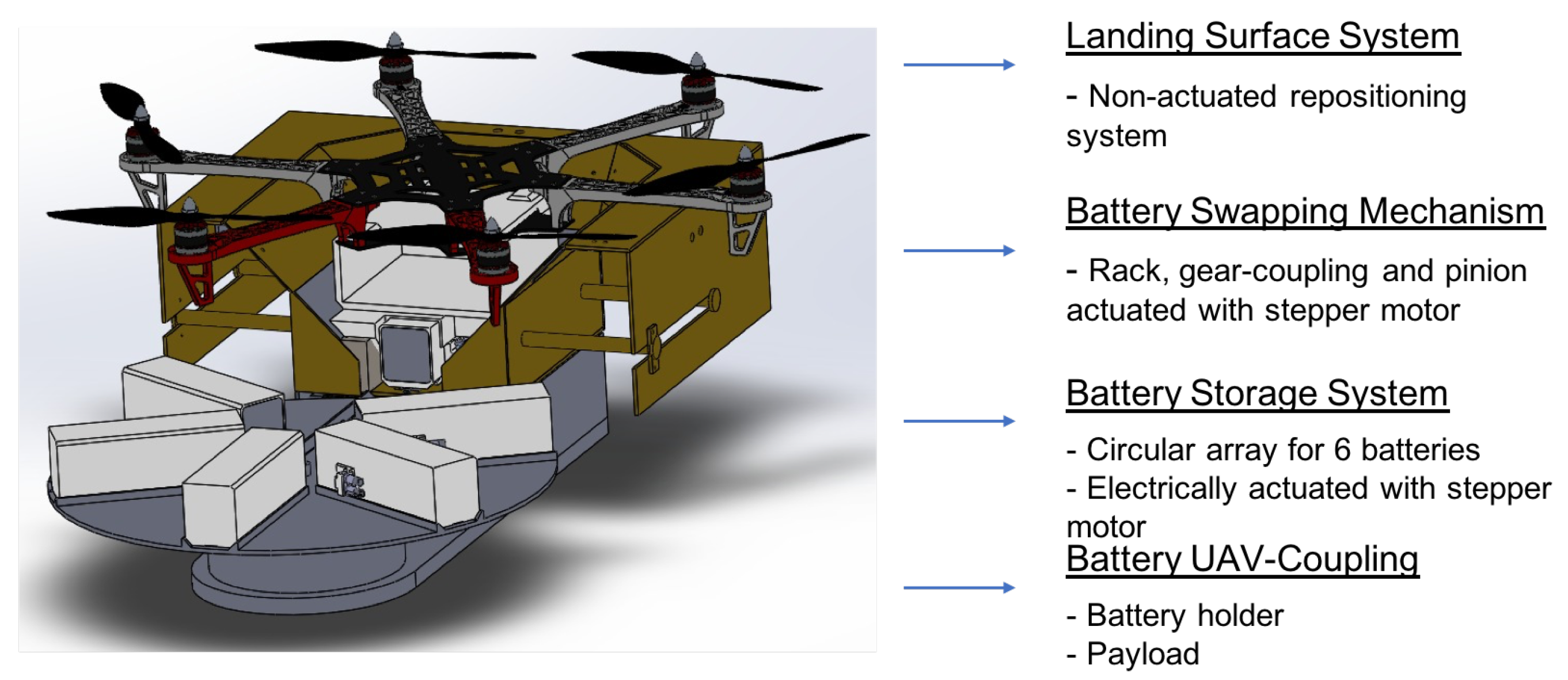
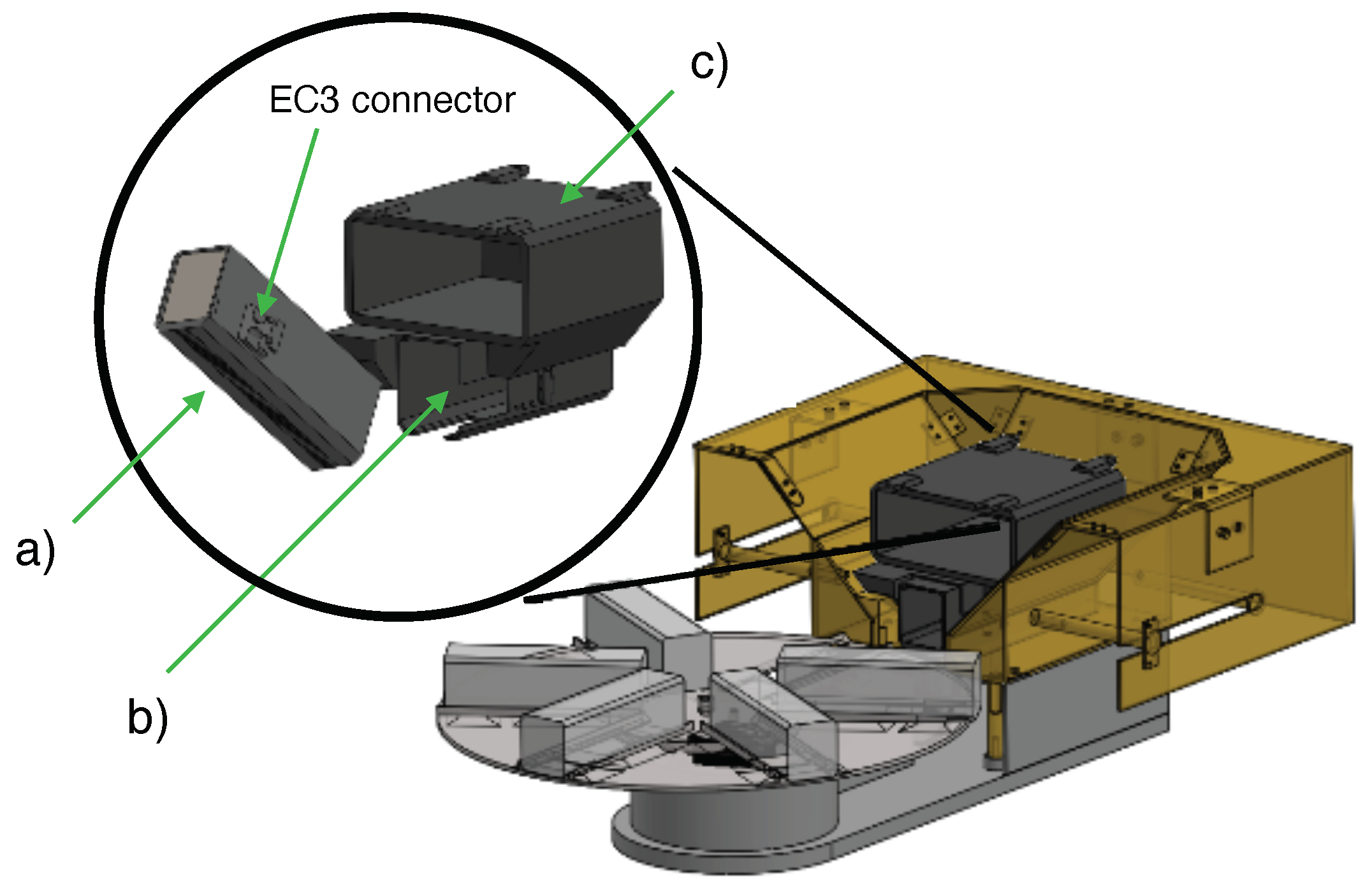
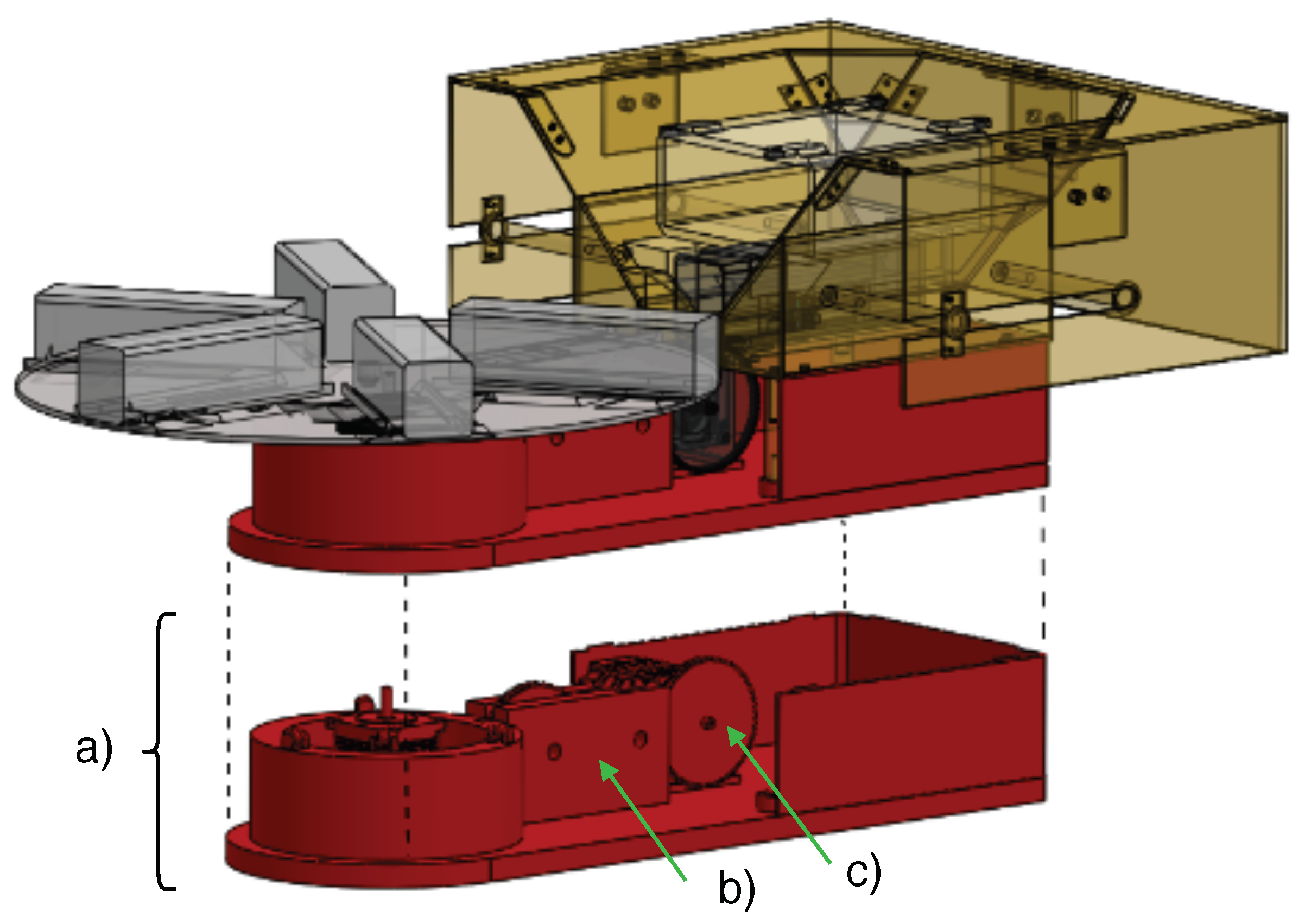
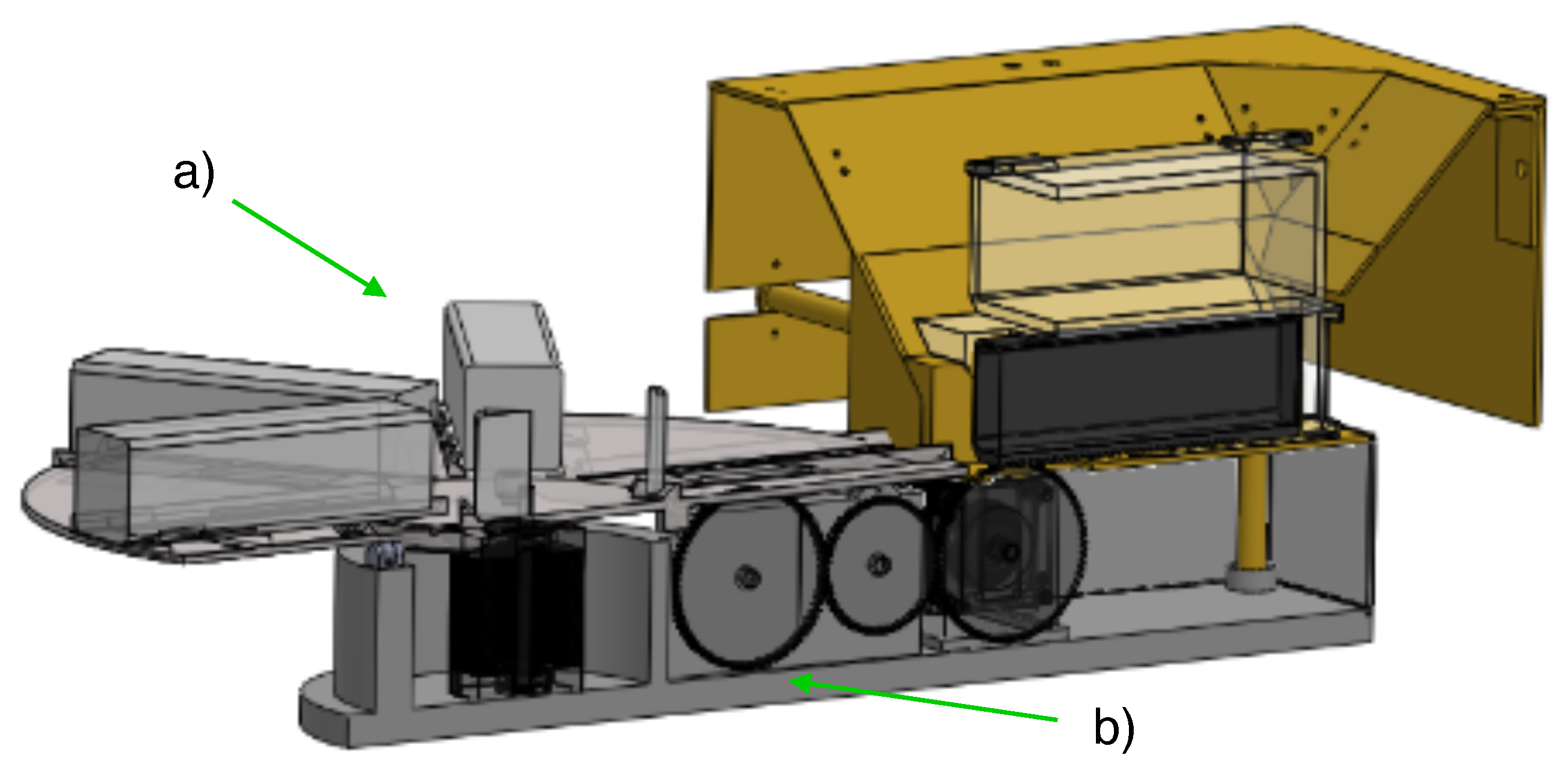
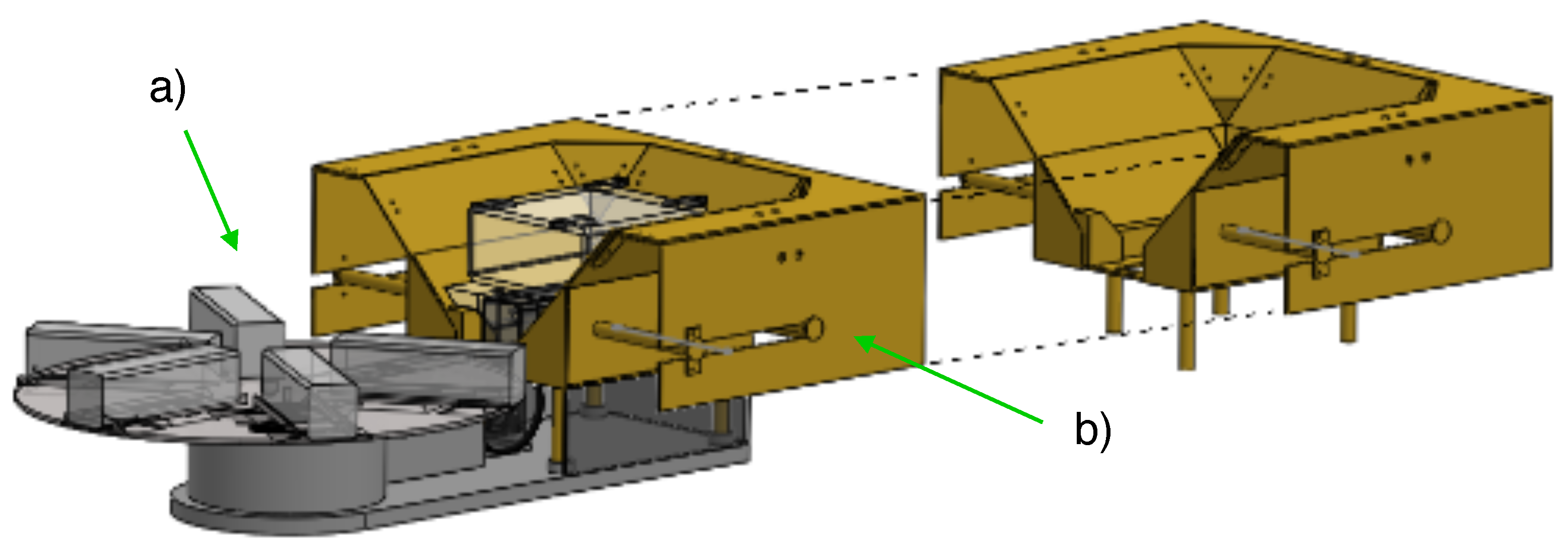
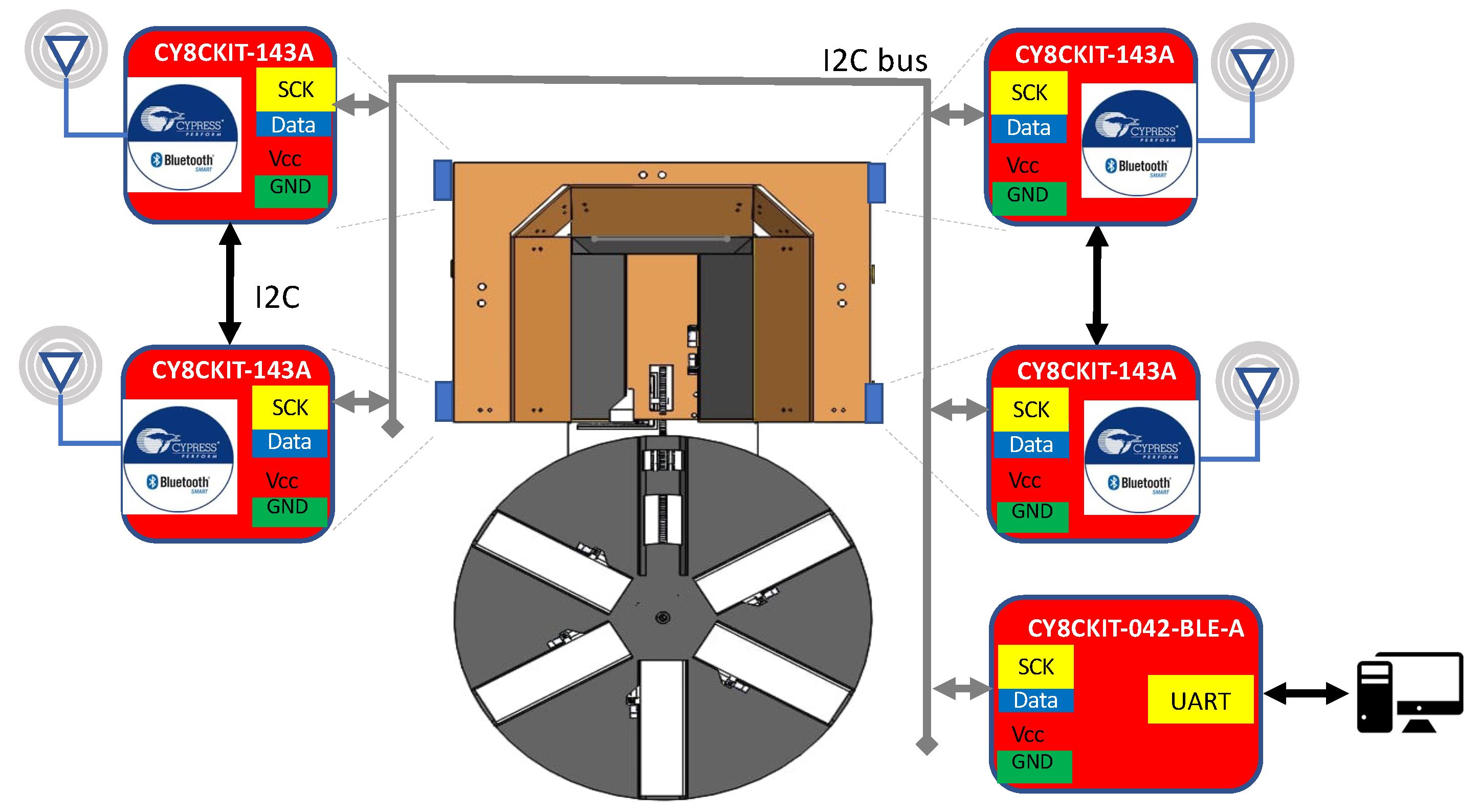
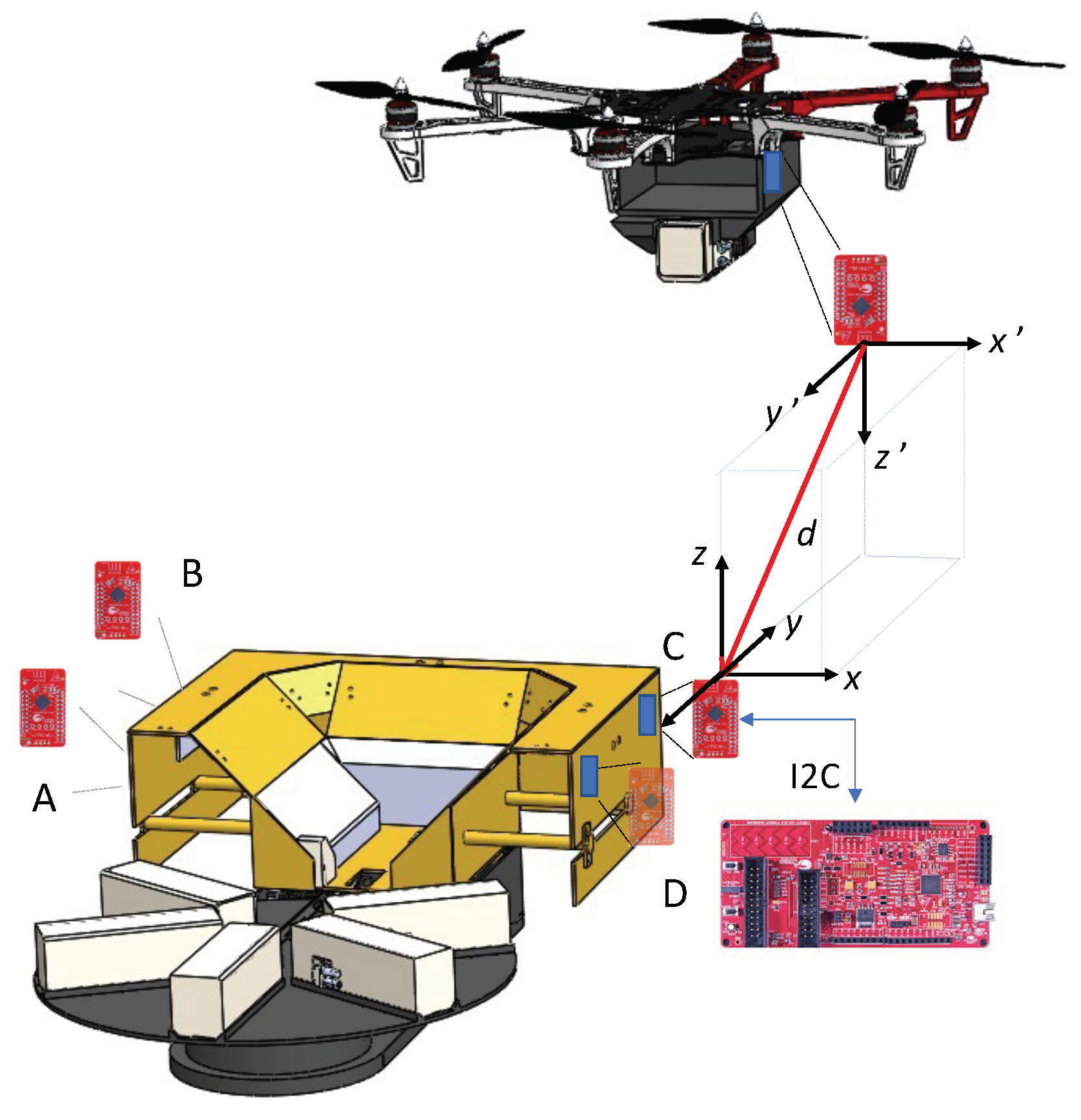
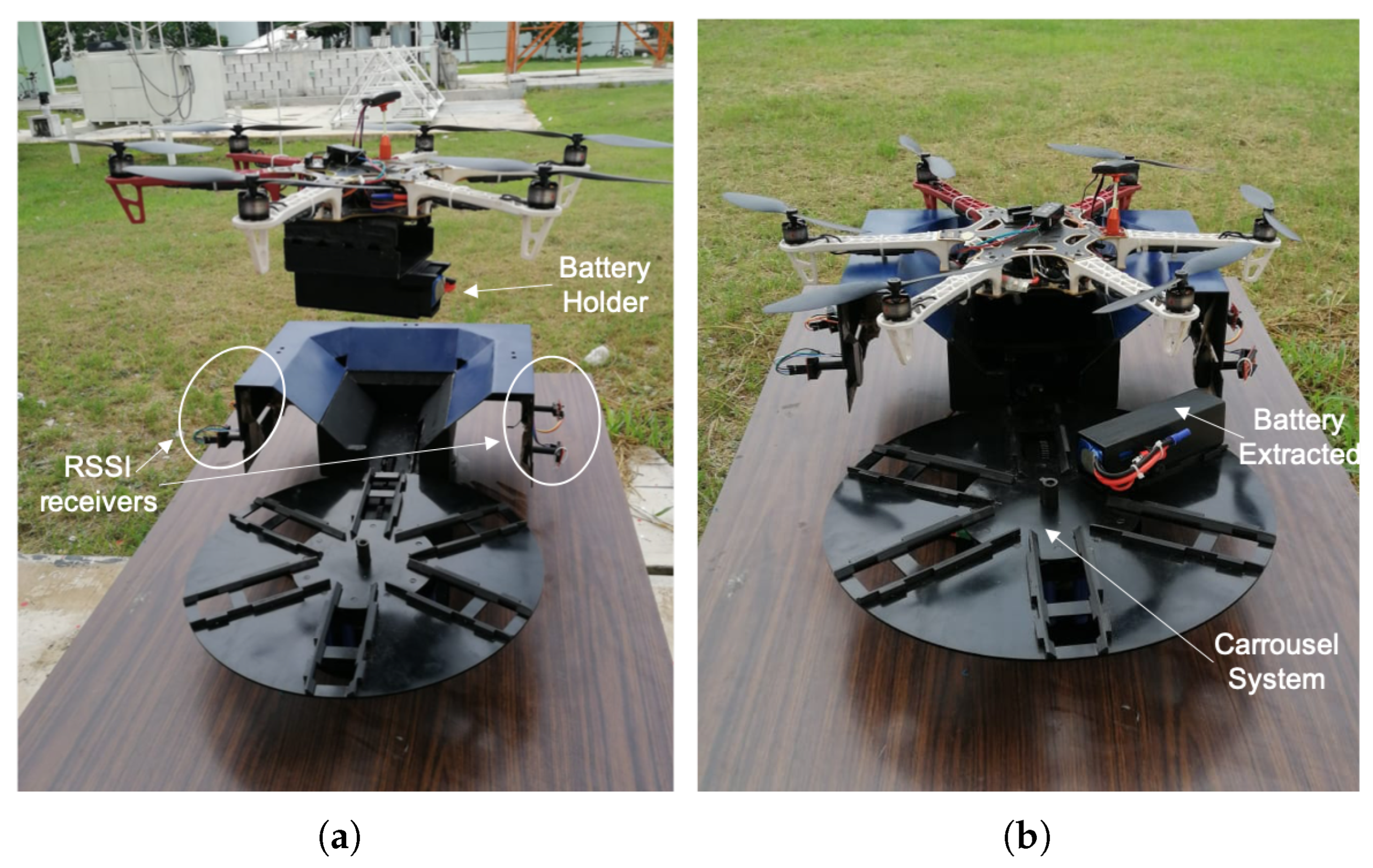

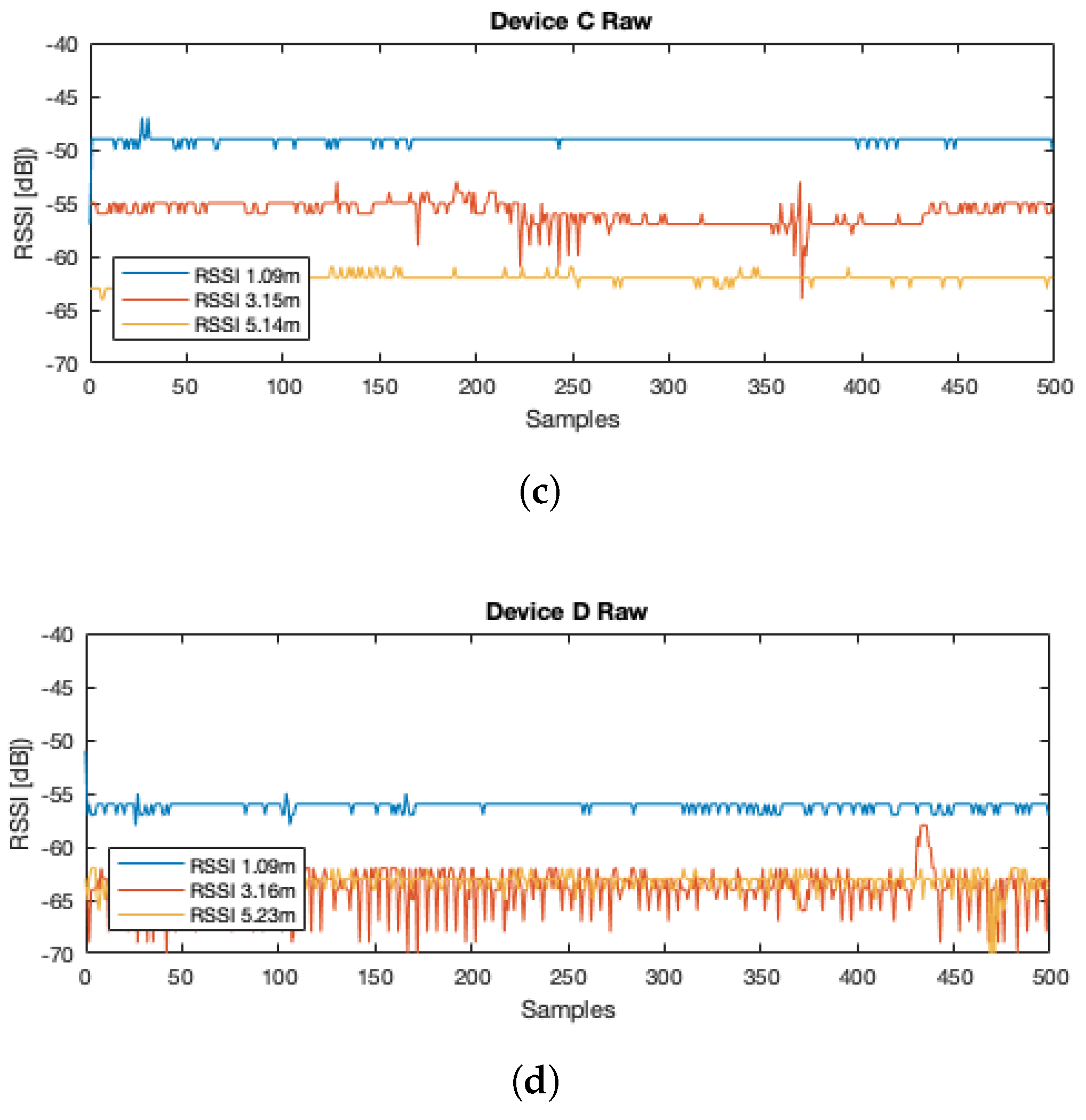
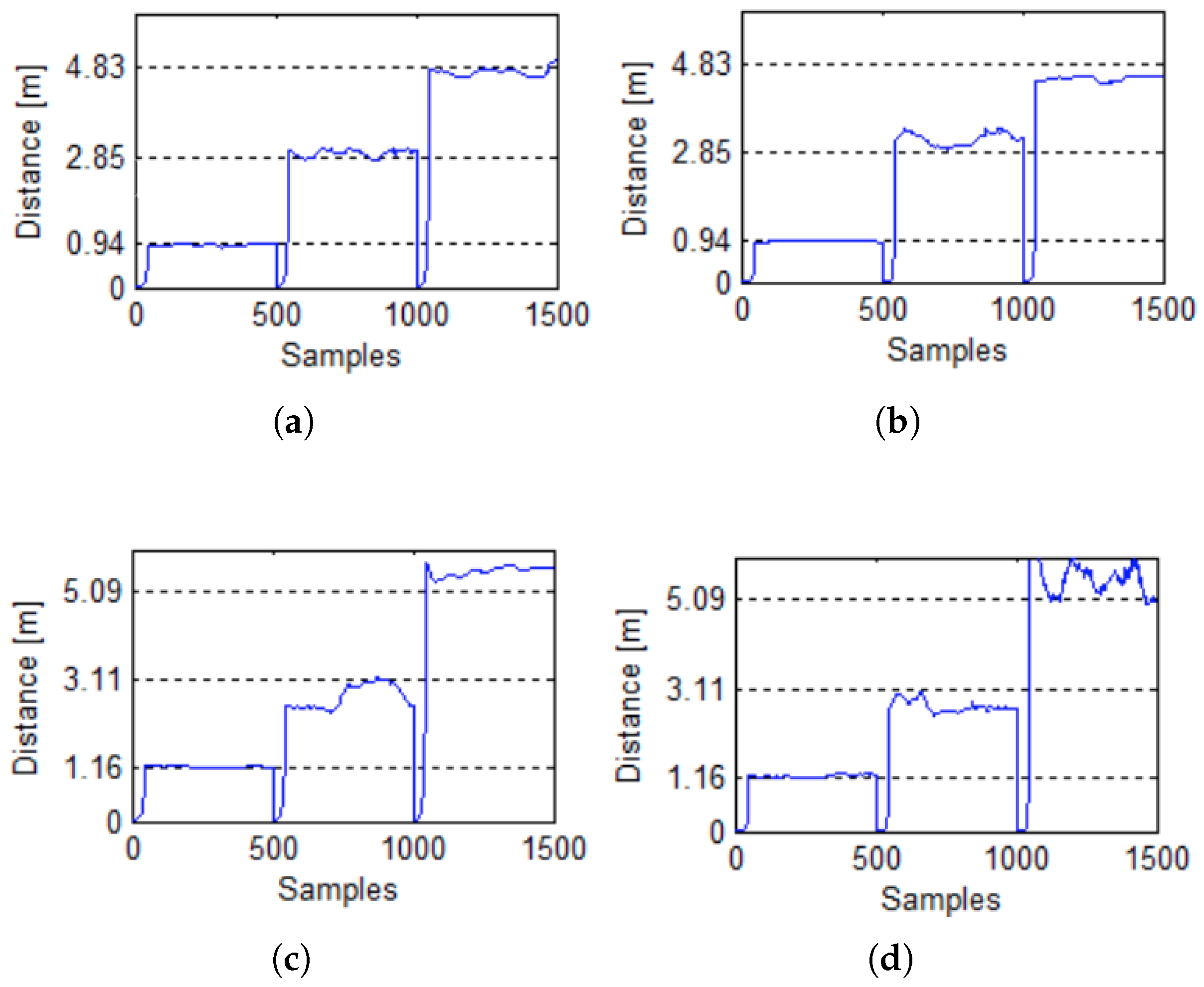
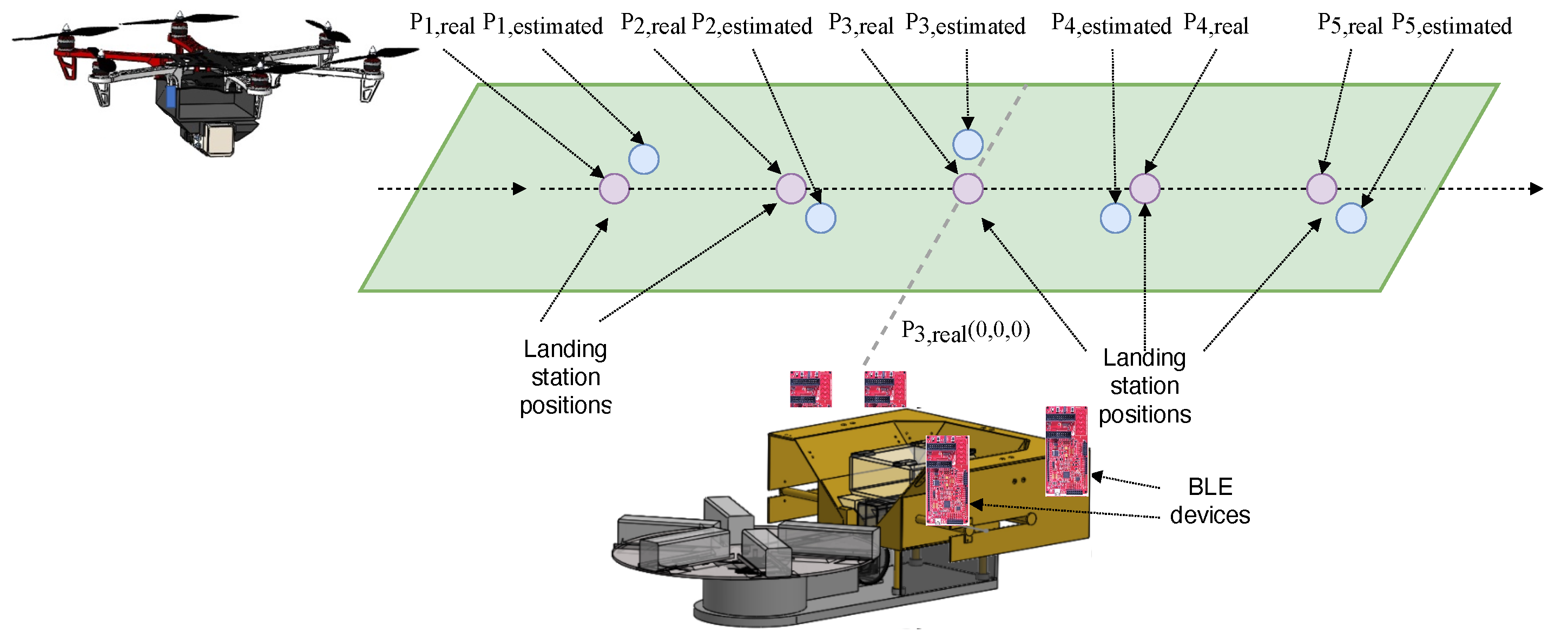
| UAV Position Coordinates | Estimated Position | Error |
|---|---|---|
| P (m) | ||
| (−4.0, 0.1, 0.5) | (, , 0.27) | (0.61, 0.34, 0.23) |
| P (m) | ||
| (−2.0, 0.1, 0.5) | (, , 0.25) | (0.20, 0.23, 0.25) |
| P (m) | ||
| (−0.5, 0.1, 0.5) | (, 0.06, 0.36) | (0.19, 0.04, 0.14) |
| P (m) | ||
| (1.5, 0.1, 0.5) | (1.33, , 0.33) | (0.17, 0.26, 0.17) |
| P (m) | ||
| (3.0, 0.1, 0.5) | (3.40, 0.42, 0.86) | (0.40, 0.32, 0.36) |
| [11] | [12] | [22] | [10] | [17] | [25] | This Work | |
|---|---|---|---|---|---|---|---|
| GLS structure | L-shape robotic arms | Dual-drum structure | — | — | — | — | Non-actuated landing surface |
| Filtering method | Infrared filters | — | – LTI filter | Extended Kalman filter | Particle swarm optimization | Gaussian filter | Butterworth digital filter |
| Hardware detection | Vision system | Vision system | — | RSSI-BLE | RSSI-BLE | RSSI-BLE | RSSI-BLE |
| Estimation algorithm | — | Markov decision process | Piecewise polynomial | RSSI-CSI algorithm | Back-propagation neural network | Nonmetric multidimensional scaling | MLE algorithm |
| Error (m) | 0.001 | — | — | 1.04 | 0.78 | 0.70 | 0.04 |
Publisher’s Note: MDPI stays neutral with regard to jurisdictional claims in published maps and institutional affiliations. |
© 2022 by the authors. Licensee MDPI, Basel, Switzerland. This article is an open access article distributed under the terms and conditions of the Creative Commons Attribution (CC BY) license (https://creativecommons.org/licenses/by/4.0/).
Share and Cite
Avilés-Viñas, J.; Carrasco-Alvarez, R.; Vázquez-Castillo, J.; Ortegón-Aguilar, J.; Estrada-López, J.J.; Jensen, D.D.; Peón-Escalante, R.; Castillo-Atoche, A. An Accurate UAV Ground Landing Station System Based on BLE-RSSI and Maximum Likelihood Target Position Estimation. Appl. Sci. 2022, 12, 6618. https://doi.org/10.3390/app12136618
Avilés-Viñas J, Carrasco-Alvarez R, Vázquez-Castillo J, Ortegón-Aguilar J, Estrada-López JJ, Jensen DD, Peón-Escalante R, Castillo-Atoche A. An Accurate UAV Ground Landing Station System Based on BLE-RSSI and Maximum Likelihood Target Position Estimation. Applied Sciences. 2022; 12(13):6618. https://doi.org/10.3390/app12136618
Chicago/Turabian StyleAvilés-Viñas, Jaime, Roberto Carrasco-Alvarez, Javier Vázquez-Castillo, Jaime Ortegón-Aguilar, Johan J. Estrada-López, Daniel D. Jensen, Ricardo Peón-Escalante, and Alejandro Castillo-Atoche. 2022. "An Accurate UAV Ground Landing Station System Based on BLE-RSSI and Maximum Likelihood Target Position Estimation" Applied Sciences 12, no. 13: 6618. https://doi.org/10.3390/app12136618
APA StyleAvilés-Viñas, J., Carrasco-Alvarez, R., Vázquez-Castillo, J., Ortegón-Aguilar, J., Estrada-López, J. J., Jensen, D. D., Peón-Escalante, R., & Castillo-Atoche, A. (2022). An Accurate UAV Ground Landing Station System Based on BLE-RSSI and Maximum Likelihood Target Position Estimation. Applied Sciences, 12(13), 6618. https://doi.org/10.3390/app12136618






